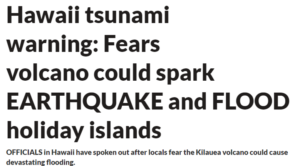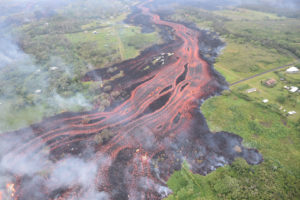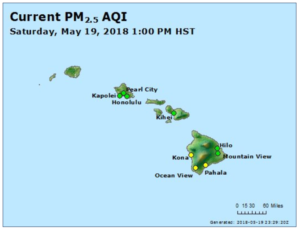Can an erupting underwater volcano cause tsunami waves?
In some cases, the answer is yes. In fact, in January 2022, a massive undersea volcano erupted in the Pacific Ocean and created tsunami waves that hit multiple continents and islands. Scientists from around the world are still mapping the aftermath of this eruption near Tonga.
We’ll come back to that case in a moment, but first, let’s roll back the clock to 2018 and a situation on the Hawaiian Islands.
Hawaii Volcano Tsunami Risk
It was the spring of 2018 when social media feeds and dramatic headlines appeared around the world, saying a major tsunami was possible as a result of the Kilauea volcano’s biggest eruption in decades. Here’s one from the Daily Star:

How is that for a headline? Hawaii tsunami could FLOOD the holiday islands? That sounds bad.
And check this article out, which ranked on page 1 of Google results about the possibility of a volcano generated tsunami:
![]()
It says, “A partial collapse of Kilauea volcano could trigger massive tsunamis that would not only engulf the Hawaiian Islands, but also devastate the U.S. Pacific Coast, as well as the coastal regions of other Pacific Rim nations…”
The Hawaii volcano could collapse and cause a tsunami that covers Hawaii? The Kilauea volcano could create a tsunami that would hit and devastate California, Oregon, Washington, British Columbia and Alaska?
Wow, that’s scary stuff.
And sometimes we don’t know what to believe about things like this.
I’d like to help clear things up, especially if you have read articles like these that have you headed (at least in your mind) for higher ground.
Hawaii Volcanic Eruption Tsunami Risk
As soon as headlines and tweets made dire warnings about the chance for a Hawaii tsunami linked to a volcanic eruption, experts who make their living monitoring the Kilauea volcano, put the real risk into perspective. From the Hawaiian Volcano Observatory:
“There have been several recent highly speculative stories, rumors and blogs about the stability of the south flank of Kilauea and the potential for a catastrophic collapse that could generate a Pacific-wide tsunami. We wish to put these speculations in their proper context by presenting observations of the current situation and an assessment of past evidence of landslides from Kilauea.”
Yes, context helps with everything and that includes trying to understand the chance of a pacific tsunami. In this case, it turns out that history does NOT support the idea of a major tsunami, although a small one is possible:
“There is no geologic evidence for past catastrophic collapses of Kilauea Volcano that would lead to a major Pacific tsunami, and such an event is extremely unlikely in the future based on monitoring of surface deformation. Kilauea tends to ‘slump,’ which is a slower type of movement that is not associated with tsunamis, although localized tsunamis only affecting the island have been generated by strong earthquakes in the past.”
So, the odds of the Kilauea volcanic eruption collapsing and crashing into the ocean to cause a major tsunami are very low. And there’s no precedent for it relating to that particular volcano, although a strong underwater quake could create a small local tsunami — and this has happened before.
Huge lava flow moving faster for now
Meanwhile, as of May 19, 2018, the USGS says a massive river of lava continues to expand and move ‘downriver,’ if you will, at the rate of 300 yards per hour. That means the molten lava makes it way across the length of 3 football fields every hour! Here’s a photo:

What about air quality now in Hawaii?
Another fear I’ve heard people talking about is the VOG or gasses produced by the eruption. Should you be worried about air quality in Hawaii this summer for your trip?
Other than short-term problems almost exclusively on the big island-you should be fine. The yellow dots on this map indicate moderate air quality, the green dots are good air quality. This map is May 19, 2018:

Los Angeles experiences a lot of days with moderate air quality each year, and Portland has moderate air quality several times each summer because of wildfire smoke moving into our skies. Both of these scenarios can be a problem for sensitive groups but for the vast majority of travelers and locals, there is not a problem.
Find the air quality in Hawaii right now.
The next time you see someone on social media sharing a story that the Hawaii volcano is going to cause a major tsunami, please share this one.
Because it never hurts to lower our collective anxiety level in this day and age.

We live in Seal Rock near Newport but we are UP hill! However, everyone will be in our yard after an event. It is good to hear a little sense out of all the hype about the volcano. And, your report on the volcano itself is interesting. One of those little inserts mentioned fracking. If the volcano is active would fracking make any difference and how stupid would they be to do fracking there. Although, we do live in stupid times! Thanks for sending this blog today. Linda Jackson, a long time follower of your blog and your TV work.